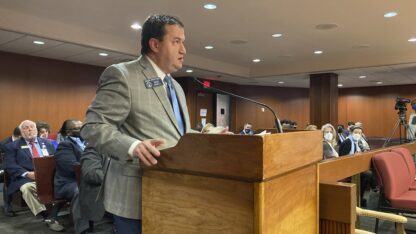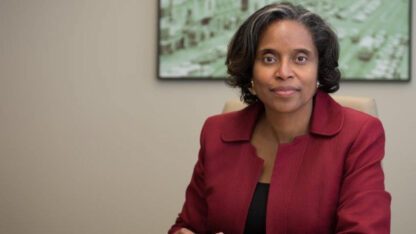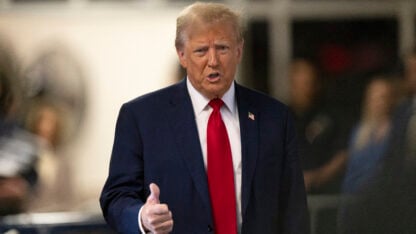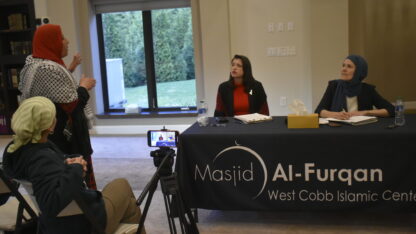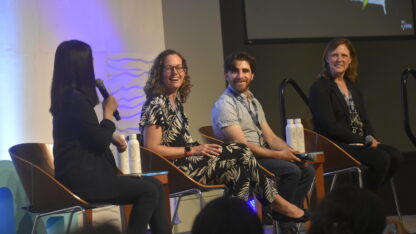In 6th District Race, Democrats Look To Minorities To Close Gap

A voter takes a “I’m a Georgia Voter” sticker after voting during Georgia’s primary election at the polling station at South Lowndes Recreation Complex in Lake Park, Ga., Tuesday, March 1, 2016. (AP Photo/Andrew Harnik)
ANDREW HARNIK / Associated Press
The national Democratic Party wants reinforcements for the closely watched 6th Congressional District election, helping pay for 10 new field workers to reach more minority voters in the traditionally conservative Atlanta suburbs.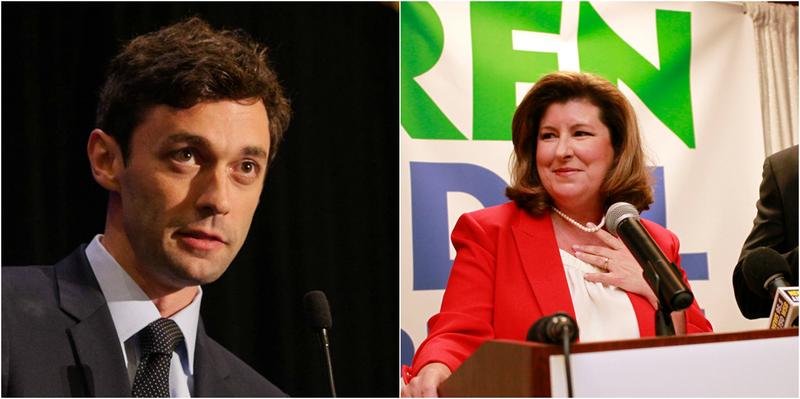
The move shows the party’s delicate balancing act as it tries to score a major upset June 20, ahead of the 2018 midterm elections, when Democrats will try to use widespread opposition to President Donald Trump to dent Republicans’ monopoly control of Washington.
Democrat Jon Ossoff has made a keen effort to woo moderates and independents who could decide his fate against Republican Karen Handel. But his party’s latest move reflects a simultaneous emphasis on traditionally Democratic voting blocs that have largely been an afterthought in a district held by Republicans since 1979.
Democratic National Committee Chairman Tom Perez said Thursday that non-white voters “will be at the heart of Jon Ossoff’s victory,” but he added that Democrats want to “talk to every single voter in this district.”
Ossoff won 48 percent in that first round. He nearly won outright over 17 other candidates, including Handel, who was the top Republican vote-getter at just under 20 percent. But Ossoff still fell more than 5,000 votes shy of the combined total won by Republicans.
Democratic Party aides initially said they would target 40,000 minority voters who were registered but did not cast ballots in April. They quickly ratcheted up the count to about 78,000. That number includes 48,000 black voters, 18,000 Asian-American voters and about 12,000 Latino voters. Party officials say their priority is to fill the new field jobs with minorities who live in or near the district.
Both major parties and aligned political action committees have poured millions of dollars and scores of paid staff into the race, which is on track to end up as the most expensive House race in U.S. history, with a tab exceeding $30 million.
Along with a May 25 special House election in Montana, the Ossoff-Handel matchup is an early barometer for how the rough start for Trump and the Republican Congress plays with voters.
Despite that, Ossoff and Handel have stepped lightly around any national overtones.
Handel joined Trump for a closed fundraiser April 28 after the president addressed a National Rifle Association gathering in Atlanta, and she campaigned alongside House Speaker Paul Ryan. Handel also has been the beneficiary of more than $5 million in spending by the Congressional Leadership Fund political action committee backed by Ryan and House Republicans.
But talking to voters directly, the former Georgia secretary of state touts her long ties to the district and her experience in state and local public office. She has called Ossoff a “hand-picked” lackey for House Democratic Leader Nancy Pelosi and blasted him for not living in the district. Ossoff lives just south of the 6th District in Atlanta.
Ossoff counters that he grew up in the district.
He is critical of Trump when asked, and championed the appointment of a special counsel to investigate potential ties between the president’s campaign and Russian powers. But he’s usually careful to promise a “bipartisan” and “problem-solving” approach, and he says his priority is boosting the technology and medical sectors in the already affluent, well-educated band of metro Atlanta’s northern suburbs.
Ossoff laments the “dark money” from Republican PACs running ads against him. But he’s also raised most of his $10 million-plus from outside the district, including through at least one Washington fundraiser headlined by Pelosi.
9(MDAxODM0MDY4MDEyMTY4NDA3MzI3YjkzMw004))
